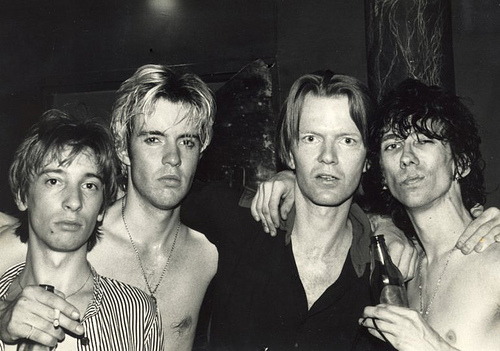
| Jacket 40 — Late 2010 | Jacket 40 Contents | Jacket Homepage | Search Jacket |
This piece is about 5 printed pages long.
It is copyright © Aram Saroyan and Jacket magazine 2010. See our [»»] Copyright notice.
The Internet address of this page is http://jacketmagazine.com/40/saroyan-on-carroll.shtml

Jim Carroll
1
I last saw Jim Carroll six or seven years ago at a reading he gave at McCabe’s Guitar Shop in Santa Monica. It had been years since I’d run into him once or twice in New York, and decades since we’d spent time together in Bolinas. In the late 1970s I’d been at a reading he gave at the Bolinas Public Utilities Building to a small audience of town residents. That night Jim read his poems in a relaxed voice and one heard the craft and care that went into them with clear pleasure. Then only a year or two later I saw him give an exciting performance with his band at The Palms in North Beach in San Francisco, now at the beginning of a whole new career in rock. The McCabe’s reading was a kind of throwback, then, after his years performing with The Jim Carroll Band. Unaccompanied he read poems and an excerpt from a novel he’d been working on. There were perhaps a hundred people in the audience, many of them longtime fans. The performance went well and Jim looked not very differently than when I’d last seen him, though he was now in his fifties. One saw nothing of the gaunt ravages in later photographs of him.
2
My wife Gailyn and I and our daughter Cream went backstage after the show and spent time sitting in the dressing room while he talked with another visitor. When he looked up from this conversation and greeted us, we complimented him on his performance, had a short and pleasant reunion and then stood up and said our goodbyes. As we left, I overheard him talking with another visitor about a performance he’d done recently. “’I’m so proud of you, Jim,’” he quoted a woman friend saying to him. There was a boyishly vulnerable quality in his demeanor — surprising to me in this charismatic, no longer young man.
3
When I left Manhattan in August 1966 at the age of 22 to go to London to join my sister and my father, who had rented an apartment that summer in Chelsea, it turned out I was leaving New York for more than a summer break. Back in America that fall, I rented with several roommates a row house in Central Square in Cambridge, Massachusetts, and it was now that I began hearing from friends in New York about Jim Carroll, who had become part of the downtown poetry scene for which the Poetry Project at St. Marks Church, just then starting up, became the headquarters. Jim had been an All-City basketball star and had gone to Trinity School — from which I’d graduated in 1962 — on a basketball scholarship. Six years younger than I was, he was still in his teens, but the buzz was that he was a poet prodigy, and I heard right away too about The Basketball Diaries, a book he’d written about his days as a heroin-addicted high school basketball star. Attending a poetry reading he gave at St. Mark’s one night, I was surprised and flattered when he announced that he would now read a couple of “Aram Saroyan imitations.” In his inimitable New York accent, he proceeded with:
4
His father was
A loafer.
His mother was
A sneaker.
5
— minimalism with street cred, as it were. Ted Berrigan told me he advised Jim not to include this in his first book, Living at the Movies. His poetry, after all, was otherwise all of a piece and in a full-voiced, romantic vein.
6
By the fall of 1974 he had arrived in Bolinas, north of San Francisco, where Gailyn and I had settled with our young daughter in 1972, and one would see him walking with his little white dog, Joe, downtown and along the beach and up on the mesa. For a while he was with a young woman named Susan, but most of the time he seemed to be by himself.
7
Jim lent me a manuscript copy of The Basketball Diaries, which was still unpublished, albeit now legendary. The strongest impression I took away from that first reading was that in a certain light his heroin use was like the flipside of the strenuous physical and psychic demands of his life as a basketball scholarship boy. Near the end of the book there was a sequence about a Greenwich Village romance that seemed full of a quieter, richer light. When I read the book again nearly a decade later when it was finally published, I asked Jim about this missing part and he responded casually that it had been cut.
8
He was on methadone during his years in Bolinas and at one point somehow arranged to have funding for a series of poetry readings at his clinic in San Rafael. He asked me to split with him the small honorarium for my reading, which I was happy to do while at the same time noting this business-savvy maneuver on his part.

Jim Carroll in later years, second from right, courtesy City Pages, 2009-09-14
9
One afternoon he accompanied me in my boat-like 1965 Chevy Bel Air, a gas-guzzler bought for $500 during the 70s gas crunch, as I did a round of errands in Marin. Among my stops was one to a recycling center to get rid of accumulated bottles, newspapers and magazines, and I remember feeling just a bit too much the Marin County ecology-minded citizen as I sat next to Jim, who I knew was operating on an entirely different frequency. But when I had trouble starting the car that afternoon, he focused to solve the problem and quickly found us jumper cables. With his Prince Valiant haircut and frame there was something courtly and old-fashioned about him that conjured up a word like “honor” or “noble.” The poem “Blue Galahad” that Ted Berrigan dedicated to Jim seems to be getting at this quality:
10
Beauty, I wasn’t born
High enough for you: Truth
I served; her knight: Love
In a Cold Climate.
11
During the better part of a decade that Jim lived in Bolinas he stayed at several different addresses, the first of which was a two-story house downtown on Brighton Road which he shared with fellow poets Jim Gustafson and Sara Schrom, among others. Later on he lived in the cabin on Bob and Bobbie Creeley’s property on Overlook Road midway between downtown and the mesa. When the poet Duncan McNaughton and his wife Genie and their children went east for a visit, Jim and Lewis Patler, a poet who later founded New College in Berkeley, house-sat their mesa home. When the McNaughtons returned and found the place in disarray and were understandably upset, Jim, in turn, was both apologetic and, it seemed, bemused.
12
“They’ve forgotten that we’re human,” he said.
13
It was toward the end of the 70s that one noticed in town a striking young woman with long blond hair who lived with others including Jim in the house on the corner at the first turn up to the mesa as you entered town. Wearing a long embroidered white dress, she was like a figure out of a fairy-tale or a pre-Raphaelite painting. Jim stopped by our house on Hawthorn Road and with greater-than-usual animation described his encounter with Rosmary Klemfuss.
14
“I couldn’t believe her beauty, you know? And she said, ‘You just want to sleep with me.’ And I just brought her this stack of about 100 poems I’d written to her.”
15
When The Basketball Diaries was published in its first small-press edition by Tombouctou Books, Michael Wolfe’s Bolinas imprint, Jim and Rosemary were now a couple, and it was remarkable to see how solicitously and gallantly he behaved with her, usually addressing her as “darling.” The two went to New York together, and when they returned Jim had a contract with the newly-formed Rolling Stone Records on the strength of a cassette of his songs he’d made, as well as a deal with Bantam Books for a mass paperback edition of The Basketball Diaries, which at last would bring the book to the wide audience it deserved.
16
Several years later, in the mid-1980s, I ran into Rosemary Carroll one winter evening in Doubleday’s on Fifth Avenue and 57th Street. The sylph-like young woman I’d first known had transformed herself into a smiling, fluent, smartly-dressed New York attorney. And Jim meanwhile had released his wonderful album Catholic Boy, with the classic anthem “People Who Died.”
17
The Miwok Indians of Northern California believed that Bolinas, a peninsula, only just shy of an island, was a healing place, and they wouldn’t settle there permanently. In effect Jim and Rosemary both seemed to find something healing there, not the least of it in each other, and then together embarked on the next phase of their lives.

Aram Saroyan
by Steven R. Keylon
Aram Saroyan’s Door to the River: Essays and Reviews from the 1960s into the Digital Age was published by Black Sparrow/David R. Godine in April 2010.